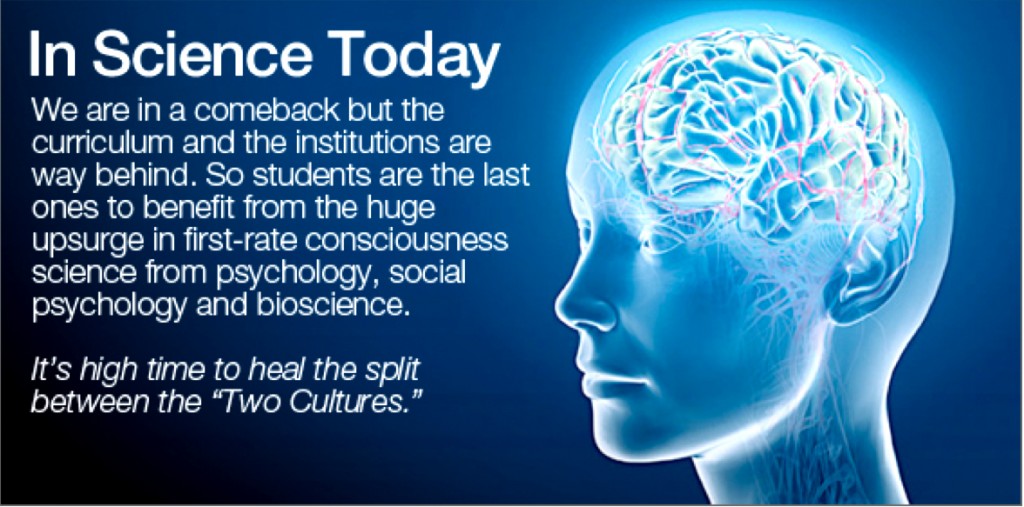
T
he scientific study of consciousness is now a legitimate endeavor at some universities and research centers around the world. Among those in the know, excitement is intense. We are privileged to study an essential aspect of the universe; for the first time, we have ready to hand methods to help us probe the most ancient questions: What is consciousness? What is it for? How does it work? We are thrilled to step onto a new continent, kin to the early quantum mechanics; the first genome-anauts.
Many of the scientists who have joined this scientific effort come to it from related fields: physics, chemistry, biology, psychology, anthroplogy, to name a few. What is more, many are reaching, in their own lives, the epoch of generativity – that part of the life cycle defined by psychoanalyst Eric Erikson in 1950 as “a concern for establishing and guiding the next generation.”
Quantum mechanics made its public debut at the 19 October 1900 meeting of the German Physical Society in Berlin, when Max Planck presented his radiation formula for the first time, although the phrase quantum mechanics was not used until Max Born‘s 1924 paper “Zur Quantenmechanik”. In 1929 Edward Condon and Philip Morse wrote QUANTUM MECHANICS, the first English-language textbook on the topic. Quantum mechanics became the portal for an ubiquitous feature of modern life in 1947 when John Bardeen, Walter Brattain and William Shockley invented the bipolar point-contact transistor.
The foundation for molecular biology was laid in James Watson’s and Francis Crick’s
A structure for deoxyribose nucleic acids published in NATURE in 1953. Their work led to the first human genome sequencing in June 2000.
Although the dates mentioned above are somewhat arbitrary in their selection, both of the game-changing discoveries, quantum mechanics and molecular biology, evolved from first-look to consensus in about 50 years. In each instance, this time frame contains two generations of scientists.
We shall underscore three events in the 1980s to mark the beginning of modern consciousness science. The first was the proliferation throughout the decade of general-task, personal computers, notably the Apple II and the IBM PC. The second was the publication of Bernard Baar’s A COGNITIVE THEORY OF CONSCIOUSNESS in 1988. The personal computer fostered a democratization of imaging data, allowing researchers, for the first time, to sample, analyze, summarize and disseminate data, information and knowledge from sophisticated equipment, including the EEG, MRI, PET. Dr. Baars’ text woke some researchers from their dogmatic slumbers, and heralded a return to the consciousness-centric psychology of William James. And third, also in 1988, the Neurosciences Institute, a prestigious, private research organization originally formed at MIT and currently under the directorship of Nobel laureate Gerald Edelman, began its own program of research in theoretical neurobiology, especially devoted to developing biologically based theories of higher brain functions, including consciousness.
By these markers, we are into the third decade of consciousness research. The dynamics of discovery suggest we are still twenty or so years from a major breakthrough impacting the human career. Nevertheless, a second generation of consciousness scientists is already developing, or searching for the right career path.
Among contemporary institutions forming like stars in the stellar dust-cloud of the data deluge in neuroscience, Why Consciousness, a branch of the Society for Mind Brain Sciences, affirms the necessity of education for the next generation, and asserts its role in education, especially public education, on the topic of consciousness science.
Given the topic, given the times, education must be a collaborative effort. Not only education in a new era of science, but new methods of education must emerge. That global brain – the internet; one’s own pattern generating, parallel processing, widely distributed wet ware; and its exponentially growing trove of data libraries, conceptual maps, information indexes, and other applications, forecast these changes.
As Neils Bohr said, “Prediction is very hard, especially about the future.” We cannot predict the specifics of new educational methods, so much as do the task and see what emerges. Students teach and teachers learn, the sort of circular causality appearing in theories of brain functioning, or as Joyce expressed it in the WAKE, “My consumers, are they not my producers?” We know enough to want to implement a new educational culture, “culture” in the biological sense of “a medium for growth.” Remove toxic influences and the body heals itself; the future forms along gradients the way life itself evolves.
In the educational world, the idea of the split between the two cultures has festered like a splinter in the flesh. At Why Consciousness we seek to remove the splinter.
Science is always, at the very least, a dialog, never a monolog. We would not trade our individual talents, but all around the world are people who see that mathematics and poetry are more alike than different. Raise this idea to a principle, and we can see clearly that real education is a conversation. The physicist Robert Oppenheimer said, “There are children playing in the streets who could solve some of my top problems in physics, because they have modes of sensory perception that I lost long ago.” Real education preserves childhood wonder and trains adult perseverance.
We remember, and perhaps chuckle over, philosopher Thomas Nagel’s expository essay, “What is it like to be a bat?” But we believe that consciousness science promises new, far reaching, inspiring answers to the question, “What is it like to be human?” This promise is why consciousness science is so important.
Did you enjoy this article? We’d love to hear your thoughts in the comments below. Please be respectful both in inquiry and debate. Subscribe to our RSS feed + sign up for email updates to stay conscious!